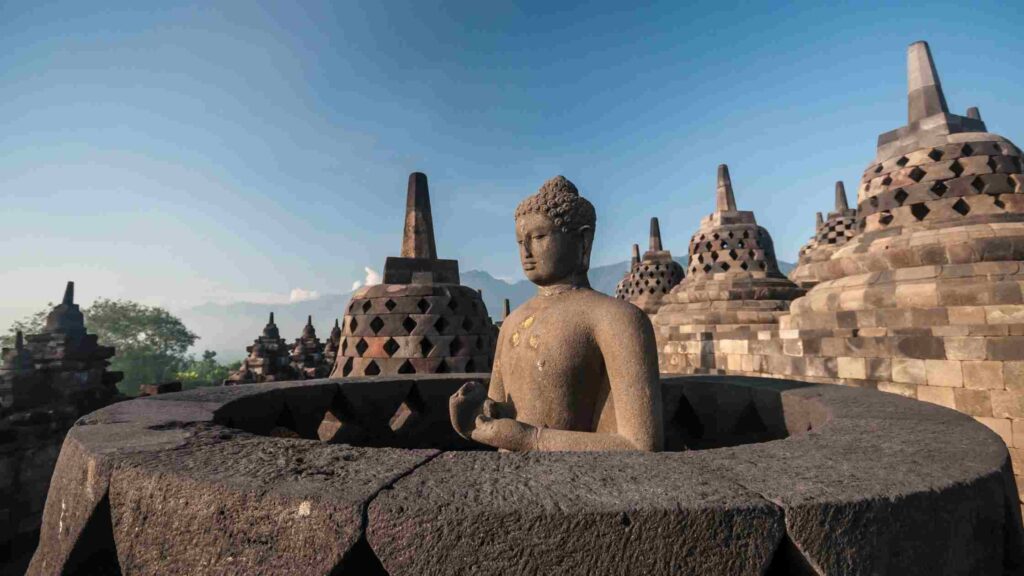Borobudur Temple is one of Indonesia’s most treasured historical and cultural landmarks. Located in Central Java, just a short drive from the city of Yogyakarta, Borobudur is the largest Buddhist temple in the world and a UNESCO World Heritage Site. It stands as a breathtaking example of ancient architecture, religious symbolism, and human craftsmanship, attracting visitors from around the globe who seek both spiritual inspiration and cultural enrichment.
Constructed in the 9th century during the reign of the Sailendra Dynasty, Borobudur was built without the use of cement or mortar. Instead, over two million volcanic stone blocks were intricately carved and stacked in a design that blends elements of Gupta art and native Javanese architecture. The temple’s construction reflects a deep understanding of geometry, symbolism, and astronomy — all aligned with Buddhist cosmology.
Borobudur is designed as a mandala, a spiritual symbol in Buddhism representing the universe. The structure has three main levels: Kamadhatu (the world of desires), Rupadhatu (the world of forms), and Arupadhatu (the formless world). As visitors ascend the nine terraces, they symbolically travel through these realms toward enlightenment, culminating at the large central stupa at the top of the monument.
Along the walls of Borobudur are over 2,600 intricately carved relief panels, stretching across 5 kilometers — the longest narrative sequence in the world. These panels tell stories from the life of Siddhartha Gautama (the historical Buddha), Jataka tales (stories of the Buddha’s previous lives), and lessons about karma, virtue, and wisdom. They provide not only spiritual guidance but also insights into life during Java’s golden age, depicting scenes of daily life, trade, agriculture, and royal processions.
At the summit, visitors are greeted by 72 bell-shaped stupas, each housing a statue of the Buddha. The panoramic view from the top is nothing short of magical, especially at sunrise. As the sun rises over the misty Kedu Valley and Mount Merapi in the distance, Borobudur seems to emerge from the earth like a vision — a serene and powerful moment that leaves a lasting impression on those who experience it.

THE RESTORATION
Borobudur was left to the ravages of nature around the 12-14th Century when the power of Java shifted to the East of the island. The reason for this shift is unknown, but it is often speculated that there was a volcanic eruption and people moved to be away from it.
There are manuscripts that relate stories of Javanese re-visiting the site in the 18th Century. But it was the “re-discovery” by the British Sir Stamford Raffles in 1814 that led to greater recognition and also preservation efforts in 1815 Raffles commissioned an initial clean up, where 100 laborers spent 45 days felling trees and moving earth from the remains. Many areas of the temple were sagging.
Activities continued with documentation and interpretation of the reliefs. It was during the work of Ijzerman in 1885 that the hidden reliefs at the base of the temple were discovered. It was these hidden reliefs at the base of the temple were discovered. It was these hidden reliefs that also revealed some Sanskrit instructions left for the carver, with lettering that was so distinctive that the construction of the temple was able to be dated to the middle of the 9th century.
In 1907 a large-scale restoration was carried out under Dutchman Van Erp that finished in 1911. The work was significant and definitely safeguarded the temple for some time. However, many of the pieces were not put back in their original positions during the restoration.
In 1956 another assessment of the temple was made by a Belgian expert who was sent by UNESCO. His assessment concluded that water damage was significant, and would need to be stemmed if the temple was to have a long term future. The hill below the temple was eroding, the foundations were being weakened and also the reliefs were being eroded.
Preparatory work began in 1963, which amongst other things discovered that the hill was not a natural hill as had always been assumed, but areas of it were loamy soil, mixed with stones and stone chips. The initial work assessed the scale of a restoration to be gigantic, and the Indonesian Government then submitted a proposal to UNESCO in 1968 outlining the works needed.
UNESCO gave full support and commenced work to raise funds for the restoration. From 1968 to 1983, research through to restoration took place under UNESCO. Specialists from the world over came to assist in the dismantling, and re-engineering of the site. A great deal of work was also done to develop procedures to prevent the microorganisms eating away the stone. The UNESCO world heritage listing of Borobudur Temple was inscribed in 1991.
Today, Borobudur is not only a popular tourist attraction but also an active place of worship. Every year during Vesak Day, thousands of Buddhist monks and pilgrims gather at the site to celebrate the birth, enlightenment, and death of the Buddha. The ceremony is marked by meditation, chanting, lantern releases, and a spirit of unity and peace that reflects the temple’s enduring spiritual power.
Visiting Borobudur offers more than just sightseeing; it’s a journey into Indonesia’s rich cultural past and a moment of quiet reflection amid the bustle of modern life. The surrounding area is also rich in attractions, from traditional villages and handicraft centers to natural wonders like the Menoreh Hills and nearby Mount Merapi.
